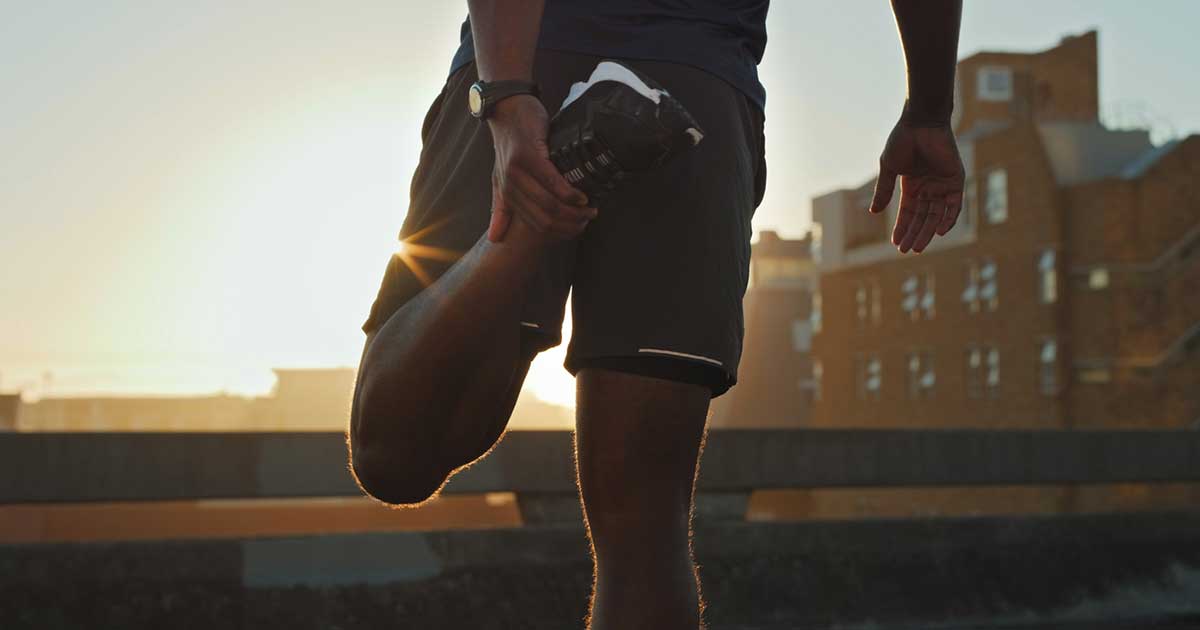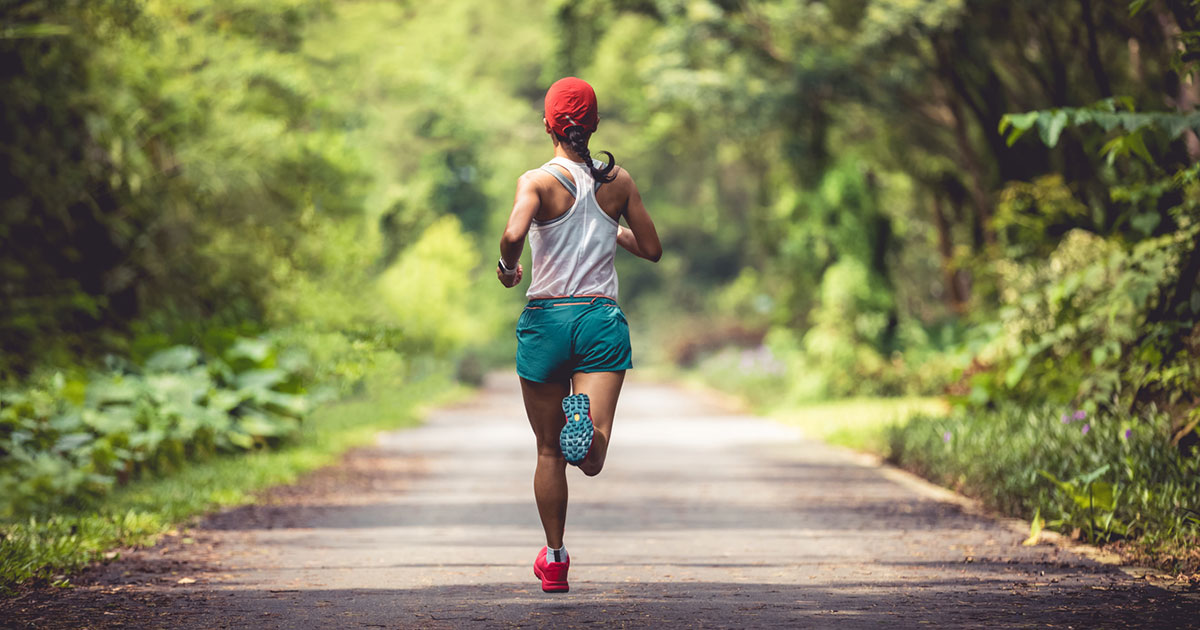Why Your IT Band Hurts and Stretches That Can Help
Advice to improve your movement, fitness, and overall health from the world's #1 in orthopedics.
If you’ve done any sort of sport with a lot of lower-body motion, you’ve probably experienced some sort of iliotibial (IT) band issue.
The IT band, a wide strip of tissue that runs from just above the hip down the outside of the thigh and attaches just below the knee, helps move the leg as it bends and extends. “There are quite a few muscles that attach to the IT band, so it helps transfer forces as the leg moves,” says Kate Baird, MA, ACSM-CEP, CSCS, an exercise physiologist on the Sports Rehabilitation and Performance Team at HSS.

The IT band is particularly susceptible to inflammation, particularly if you perform a sport like running or biking, because of the repetitive motion. “If there are any compensations or weaknesses in your frame or form, you may end up feeling it along the IT band or outer hip and/or knee,” says Baird. Bending and straightening the knee for mile after mile creates a sort of friction, and that can lead to aches and injury if you have weakness in any of the muscles along the area, says Baird.
She says to think of the area like a spider web: When you pull on one area, the entire web skews toward it. “The IT band responds like that – when any of the attachment points are weak, overused or tight, the lack of stability gets transferred down the leg to the knee and the IT band can become inflamed,” she says.
Keep the IT band healthy
Many things can contribute to IT band inflammation, including sudden increases in training volume, constantly running or riding the same route with certain ground angles (think a track that curves), poor form and muscle weakness. To address these issues, make sure you are cross training for strength and stability in your sport, that you pay attention to form and that you add mileage gradually, and change up your route as often as you can.
And intersperse your activity with plenty of strengthening sessions for the core, pelvis, hips, knees, feet and ankles. “The stronger the surrounding muscles, the better your stability, the better your mechanics, and the less likely you're going to transfer forces down through the knee in a suboptimal way,” says Baird. Also change out your running shoes at least every 300 miles to make sure your legs are supported from the bottom up.
While the IT band itself can’t really be stretched (it’s a little different from muscle), stretching the muscles surrounding it improves flexibility and range of motion. The moves below are some of Baird’s favorites that can be done at least one to two times daily.
Standing Iliotibial Band Stretch
- Stand up straight and cross your right leg in front of your left at the ankle. (The front leg can bend if you need.)
- Raise your left arm overhead and reach it toward your right side. If you don’t feel steady, lean your left side against the wall or hold on to a chair or piece of furniture with your right hand. (The leg that is behind is the one being stretched.)
- You should feel a stretch along your left hip. If you don’t, slowly stretch a little deeper to the side while keeping your torso straight.
- Hold for 20 to 30 seconds.
- Repeat on the other side.
- Alternate sides for a total of three to five times on each side.
Seated Cross-Over Twist
- Sit on the floor with your legs straight out in front of you.
- Let your arms fall naturally beside you and place your hands flat on either side of your hips, fingers facing toward your front.
- Bend your right knee and place your right foot on the outside of your left knee.
- Bring your left arm up and hold your right knee with your left hand.
- For an even greater stretch, place your left elbow on the outer side of your right knee.
- Make sure both sits bones (in your butt) remain on the floor.
- Turn your chest, head and eyes to the right. Breathe naturally for about 30 to 45 seconds, then bring your head, eyes and chest back to center.
- Place your right foot back on the floor.
- Repeat with your left leg.
Pigeon
- If you’re very tight, begin on your back with both knees bent and feet flat on the floor.
- Lift your right leg up and place your right ankle on your left thigh, just below the knee. You’ll be creating an upside-down four with your legs.
- Thread your arms through your legs and clasp the back of your left thigh.
- Gently lift your left leg as you push your right thigh away with your right elbow.
- You should feel a stretch in the side of your right glute.
- Hold for 30 to 45 seconds.
- Repeat with your left leg.
Once you get comfortable with lying pigeon, you can try a seated pigeon. Keep in mind that this is a complex stretch, so take your time with it.
- Start on all fours, hands under shoulders, knees under hips.
- Scoot your left foot backward, keeping the top of your foot on the floor and your heel in a neutral position.
- Bring your right knee forward and scoot your right foot toward your left wrist, while your left leg/hip slides backwards.
- Stop when you can’t go anymore.
- Make sure your hips are square. If that’s not accessible, you can put some pillows or a yoga block under your right glute to help support you in the position.
- This might be enough of a stretch. If you need more, lean gently forward and bring your elbows down to the floor.
- Breathe naturally for 30 to 45 seconds.
- Gently return to the all-fours position.
- Repeat on the other side.
Supine IT Band Cross-Over (using a band or strap)
- Lie on your back with your legs bent and feet flat on the floor.
- Make sure your pelvis stays neutral throughout the stretch.
- Lift your bent right leg up and loop a yoga strap, a rolled-up towel or even a robe belt around your right foot.
- Straighten your right leg, keeping the bottom of the foot facing the ceiling.
- Bring your right leg toward the left side. Don’t let your hips lift off the floor.
- Breathe naturally for about 20 to 30 seconds (or longer if you want), then bring the leg back toward the right.
- Bring it to the left side again.
- Return your right foot back to the floor.
- Repeat with the left leg.
Standing Quad Stretch
- Stand next to a wall or chair with legs hip-width apart.
- Hold the wall gently with your left hand.
- Bend your right leg up and grasp your ankle gently with your right hand.
- Keep your knees in line and pull your ankle upwards. Keep your right shoulder relaxed and open.
- Squeeze your right glute and tuck your pelvis under to really feel the stretch in your right quad.
- Hold for 30 to 45 seconds.
- Return the right foot to the ground, turn around, and repeat on the other side.
Published 6/13/2023





